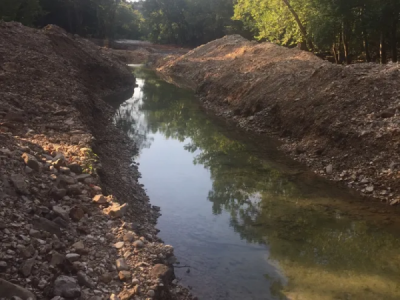
Posted on September 17, 2020
A landowner’s efforts to rebuild a crossing on Bull Creek where three people have drowned has drawn more scrutiny from the U.S. Army Corps of Engineers.
The crossing was torn out recently but the contractor that landowner Steve Johnson hired dredged a deep channel in the creek and piled gravel up to 10 feet high along the edges, according to the Corps.
A Corps inspector looked at the dredging site on Wednesday, and it is a clear violation of the Nationwide Permit under which the creek crossing was allowed to be rebuilt, according to Corps spokesman Jay Townsend.
“Our attorneys are drafting another letter of noncompliance and making a list of all of the violations we see,” Townsend said Friday. “He will have to present a plan to us to fix and restore the stream bed, or he will be issued a letter to appear before a federal magistrate.”
The Missouri Department of Natural Resources also is investigating whether the creek excavation violated any Missouri water regulations.
Reached Friday, Johnson said his attorneys have told him not to make any comments to the media. He declined to name the company that excavated the creek.
Johnson, and his previous contractor Tom Boyce Excavating of Branson, currently are being sued by survivors of two of the three people who drowned when their kayaks capsized at the crossing that Johnson had built to connect his tracts of land.
After the drownings were brought to the Corps’ attention, the crossing was inspected and found to be taller and wider than the Corps permit allowed. Johnson opted to tear it out and start over with a different bridge design and different contractor.
Townsend said the deep and lengthy dredging was done to create a channel so water from Bull Creek wouldn’t reach concrete footings that were going to be poured for the new crossing.
“The landowner says he was unaware this was the way it was being done,” Townsend said.
The stream bed destruction, approximately 400 yards long, was discovered by Loring Bullard, chair of the newly formed Schoolcraft Chapter of the Ozark Society and former executive director of the Watershed Committee of the Ozarks.
“It’s devastation. It was awful. It was tragic,” Bullard said Friday. “The guy had taken a track hoe down the middle of the stream and piled gravel 10 feet high. It destroys the stream, and there’s all kinds of habitat that will be destroyed when you do this excavating work.”
Bullard said the gravel that was piled up exposed mud on the creek bed that turned the normally clear creek muddy.
“That sediment creates problems downstream where critters live in the gravel beds,” he said. “We need to be sure this doesn’t happen again.”
Bullard said the ongoing issues with Johnson’s Bull Creek crossing — and the Nationwide Permit that allowed it to proceed — shows the lack of oversight when such a permit is issued for work in a creek environment.
The new Ozark Society chapter has created a Rivers Committee to focus on issues like the ones created by the Nationwide Permit for the Bull Creek crossing. Bullard said the committee’s goal is to find better ways to protect local streams from the kind of damage that he says has occurred from Johnson’s project.
Jessica Luraas, chair of the Rivers Committee, said she hopes it can partner with other groups and agencies to look at ways to remove low-head dams and crossings or make them safer, with less impact on the environment.
Johnson’s controversial Bull Creek crossing could be the group’s “poster child” for tackling issues related to Nationwide Permits for creek projects.
“Here they get it removed and now have all these other unintended consequences,” Luraas said.
Source: news-leader.com





